HISTORY OF RUSSIAN SUKHOI
FIGHTER AIRCRAFT - Page 2
Sukhoi Employs Over 29,000 Workers
The Sukhoi SU-17 FITTER was a Soviet attack aircraft developed from the SU-7 fighter bomber. Over 2867 were built, and it had a long life and was widely exported to Middle Eastern Air Forces. The production aircraft was named FITTER-C. In a move to eliminate single engine strike aircraft from it's inventory the Russian Air Force retired it's last SU-17M4 along with it's fleet of MIG-23/27s in 1998. Max speed of the SU-17 was reported as 1155 at altitude. Wings could be either swept or spread.

SUKHOI SU-24
The Sukhoi SU-24 FENCER is an all weather interdiction and attack aircraft which is still operational. The two seat, twin engine SU-24 carried the USSRs intergrated digital NAV/ATTACK system. Over 1400 were built and it remains in service. The SU-24 wings have four sweep settings for various flying requirements. The variable geometry wing provides excellent STOL performance. Maximum speed is reported at 1440 mph, Mach 2.18 at altitude, and a ceiling of 57.000 ft. Later modifications required name changes to FENCER A,B,C, and D. It is planned to be replaced by the SU-34.

SUKHOI SU-25
The Sukhoi SU-25, NATO name FROGFOOT, was designed to give close air support for ground forces. After over 25 years in service the SU-25 has seen combat with several Air Forces. Over 1024 have been built, presently in operation. It was heavily involved in the Soviet war with Afghanistan. Many variants have developed and more modifications are planned. For armament the SU-25 carries a six barrel 23mm rotating cannon and the complete wide range of missiles.
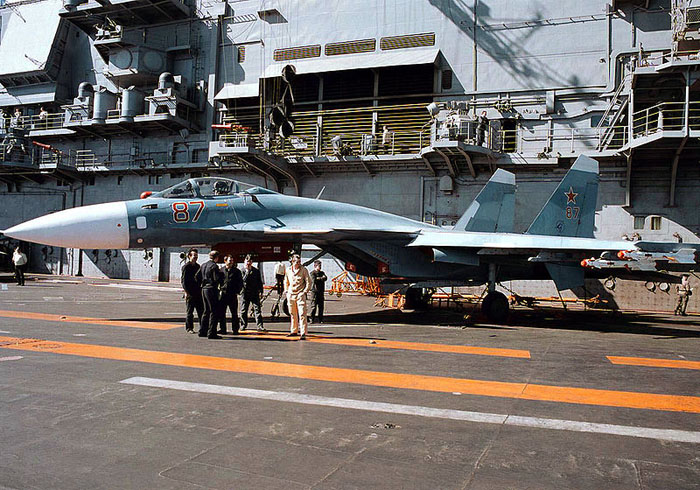
SUKHOI SU-27/33
The SUKHOI SU-27/33 FLANKER is a one seat mach-2 class jet fighter, intended as a direct competitor for the large U.S. 4th Generation fighters, with long range, heavy armament, sophisticated avionics and high agility. The SU-27 most often flies superiority missions, but can perform all combat operations. It is presently in production, in service, with 680 built so far. The basic design of the SU-27 is similar to the MIG-29, but it is substantially larger. The SU-27 had the Soviet Union's first operational fly- by -wire control system. The aircraft is exceptionally agile, with thrust vectoring allowing the fighter to perform hard turns. The Naval version of the FLANKER, the SU-27K incorporates canards for additional lift and short take offs. The SU-27 is armed with a 30mm cannon with a most impressive variety of missiles and other weapons. As usual, the FLANKER has many variants such as FLANKER-B, FLANKER-C, and FLANKER-D which is the carrier-based single seater with folding wings and high lift devices. Also known as the SU-33. Approximately 680 SU-27s have been produced. Top speed is reported at 1550 mph at altitude, and a ceiling of 62,523 ft.
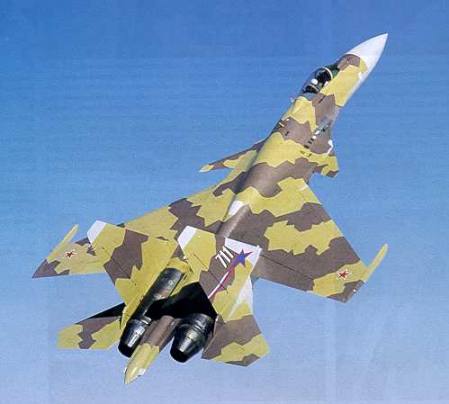
SUKOI SU-27/37
The SUKOI SU-37, NATO name FLANKER-F, is a Russian experimental multi-role jet fighter with thrust vectoring. The SU-37, initially derived from the SU-27. The SU-37 includes many updates over the SU-27, including all-weather and ground attack capability. Other updates include multi-role passive electronically scanned array radar with synthetic aperture, terrain avoidance, terrain mapping and a rear facing radar. The thrust vectoring nozzles are variable pitch and can be operated differentially to provide a rolling moment. It is the first Russian fighter with the hands on throttle and stick system, and the first with side stick. The ejection seat is inclined 30 degrees backwards to help counter the effects of high G-forces, The SU-37 can carry air-to-air and air to surface weapons on 12 stations. Maximum speed is 1550 mph with a ceiling of 59,100 ft. It also carries a 30 mm cannon. Many upgrades to the SU-27 such as upgraded engines, radar, and a digital fly-by-wire control system. The new design was changed to SU-35, and by adding the thrust vectoring nozzles it became the SU-37. The SU-37 is yet to go into production, but advanced to the SU-35BM, typical with the many variants used by the Russians.

SUKHOI SU-30
The SUKHOI SU-30, NATO reporting name FLANKER-C, is a modernized version of the SU-27UB, and has many varieties. Aircraft designed for different countries were given different designations, such as the SU-30 MKI developed for India. Even though the SU-27 had good range, certain air defense tasks required a long-range interceptor. Major modifications gave it the required range, and provided a capability for ground attack and to track and engage multiple targets simultaneously. The two man crew contributes significantly to enhanced combat capabilities. Speed is reported at 1320 mph with a ceiling of 56,800 ft. An impressive assortment of the sophisticated weapons system allows all versions to carry up to eight tons.
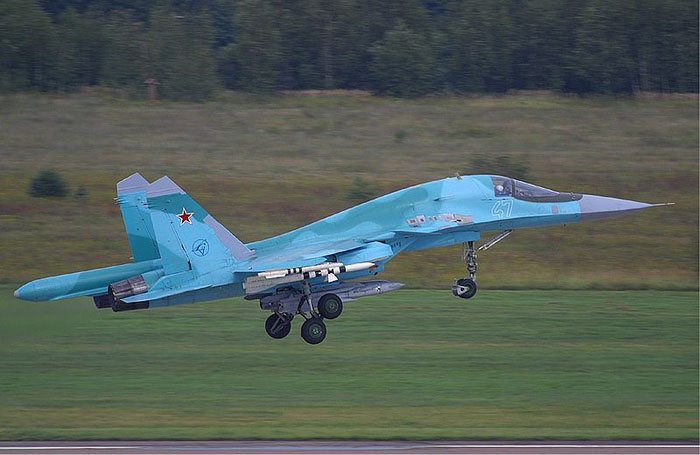
SUKHOI SU-34
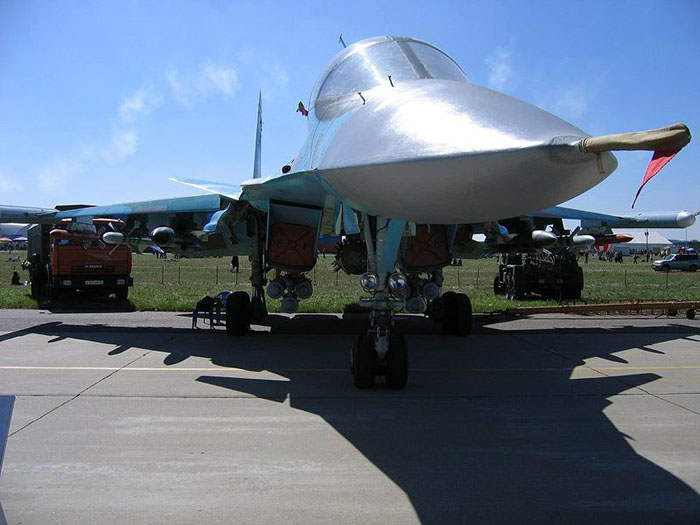
SU-34 NOSE
The SUKHOI SU-34, NATO designation FULLBACK which will replace the SU-24, export designation SU-32. Budget restrictions have caused the program to stall repeatedly. At the 1999 Paris Air Show the aircraft was nicknamed the Platypus due to the unusual shape of the nose. The aircraft has an entirely new nose and forward fuselage with a cockpit providing side-by-side seating for a crew of two. An air regiment of 44 SU-34s will be operational by 2010, and a total of 200 by 2015, replacing 300 SU-24s. Able to carry 17,650 pounds of ordnance including the latest Russian precision-guided missiles. The aircraft depends heavily on the two main computers. Speed is reported at 1180 mph at altitude, and a ceiling of 49,200 ft. The SU-34 carries a most impressive array of the latest Russian missiles.
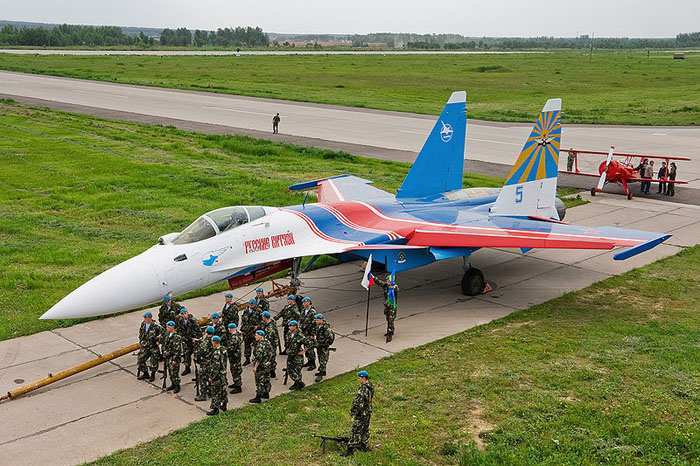
SUKHOI SU-35
The SUKHOI SU-35, NATO name FLANKER E, is a fourth generation heavy class, long range, multi-roll fighter. It is a close cousin of the SU-30MKI. It has the usual name changes and variants. Five SU-35s were delivered to the Russian Knights precision flight team. The SU-35 has been nicknamed "Super Flanker." Now in production deliveries began in 2009. Many electronic modifications use an improved passive electronically scanned array radar, upgrades to it's avionics and electronic systems, digital fly-by-wire, rear looking radar for firing semi-active radar missiles. The new radar system can track up to 30 aerial targets and engage up to eight. Maximum speed reported at 1500 mph at altitude. Service ceiling is 59,000 ft. It carries a 30 mm cannon, air-to-air and air to surface missiles, and laser guided bombs.

SUKHOI SU-47
The SUKHOI SU-47 BERKUT is an experimental supersonic jet fighter developed by SUKHOI Aviation Corporation. NATO reporting name is FIRKIN. The aircraft is distinguished by it's forward swept wings and is a 5th generation jet fighter. The forward swept wings allow superb maneuverability and operation at high angles of attack. The wings are made of composite materials as conventional materials would not be strong enough. Russian funding has frozen development of the project, but such a fighter must be as advanced as the U.S. F-22 RAPTOR, but also compete for funding with the more conventional MIG 1.44. Due to it's large wingspan the SU-47 will need to be equipped with folding wings in order to fit inside Russian hangars.
The main problem with such a design is that it produces strong rotational forces that try to twist the wings off, especially at high speeds. American analysts speculate the Russian design is unreliable and will need to be replaced with a conventional swept-wing layout. All performance information is strictly speculation as the aircraft is very experimental.
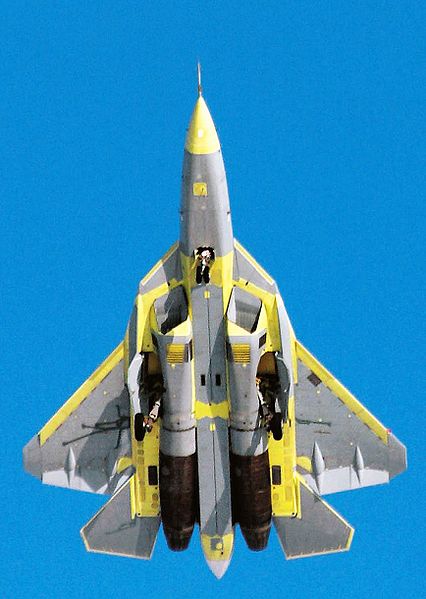
SUKHOI PAK FA T-50
The Sukhoi PAK FA T-50 as a 5th generation jet fighter being developed by Sukoi OKB for the Russian Air Force. It is intended to replace the MIG-29 FULCRUM and the SU-27 FLANKER. It is designed to directly compete with the American F-22 RAPTOR. First flight was Jan. 29 2010. Most information at present is classified. All performance information is speculation.
Research by Wayland Mayo, Website Historian.